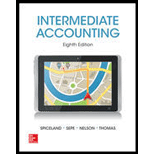
Concept explainers
1.
Contingent liability is one form of liability that arises based on a particular outcome of a specific event. They are possible obligation that might arise or might not arise based on the future events. It is otherwise called as probable liability or eventual liability. Following are examples of contingencies:
- Income tax disputes
- Discounted notes receivable
- Lawsuits
- Debt guarantees
- Failure to follow government regulations
Loss contingency:
Loss contingency is a contingency where existing situation or circumstances where potential losses are resolved and thus, future events are occurred. Examples for loss contingency are as follows:
- 1. Possible repair to a product under any warranty
- 2. Defendant in a lawsuit
- 3. Uncollectible receivables
To determine: The appropriate means of reporting each situation and prepare necessary journal entries and disclosure notes.
2.
To prepare: the necessary journal entries and disclosure note.
Want to see the full answer?
Check out a sample textbook solution
Chapter 13 Solutions
Intermediate Accounting w/ Annual Report; Connect Access Card
- Please provide the solution to this general accounting question with accurate financial calculations.arrow_forwardI need the correct answer to this general accounting problem using the standard accounting approach.arrow_forwardI am searching for the accurate solution to this general accounting problem with the right approach.arrow_forward
- Please provide the correct answer to this general accounting problem using valid calculations.arrow_forwardCan you solve this general accounting problem using appropriate accounting principles?arrow_forwardI need help solving this general accounting question with the proper methodology.arrow_forward
- Switzer Ltd. reported net income of $385,000 for the year ended December 31, 2020, and had 700,000 common shares outstanding throughout the fiscal year. On July 1, 2020, the company issued 3-year, 4% convertible bonds at par for $800,000. Each $1,000 bond is convertible into 100 common shares. Using the residual value method, the liability component's present value of cash flows for interest and principal at a market rate 6% for non-convertible bonds was $757,232. The equity component was for the remainder of $42,768. Switzer Ltd.'s tax rate is 25%. What is the 2020 earnings per share? Question 7Answer a. Basic EPS - $1.00 Diluted EPS - $0.90 b. Basic EPS - $0.49 Diluted EPS - $0.54 c. Basic EPS - $0.49 Diluted EPS - $0.47 d. Basic EPS - $0.55 Diluted EPS - $0.54arrow_forwardPlease help me solve this general accounting question using the right accounting principles.arrow_forwardPlease explain the solution to this general accounting problem with accurate principles.arrow_forward
- I am looking for the correct answer to this general accounting question with appropriate explanations.arrow_forwardCan you help me solve this general accounting problem using the correct accounting process?arrow_forwardPlease provide the accurate answer to this general accounting problem using valid techniques.arrow_forward

 AccountingAccountingISBN:9781337272094Author:WARREN, Carl S., Reeve, James M., Duchac, Jonathan E.Publisher:Cengage Learning,
AccountingAccountingISBN:9781337272094Author:WARREN, Carl S., Reeve, James M., Duchac, Jonathan E.Publisher:Cengage Learning, Accounting Information SystemsAccountingISBN:9781337619202Author:Hall, James A.Publisher:Cengage Learning,
Accounting Information SystemsAccountingISBN:9781337619202Author:Hall, James A.Publisher:Cengage Learning, Horngren's Cost Accounting: A Managerial Emphasis...AccountingISBN:9780134475585Author:Srikant M. Datar, Madhav V. RajanPublisher:PEARSON
Horngren's Cost Accounting: A Managerial Emphasis...AccountingISBN:9780134475585Author:Srikant M. Datar, Madhav V. RajanPublisher:PEARSON Intermediate AccountingAccountingISBN:9781259722660Author:J. David Spiceland, Mark W. Nelson, Wayne M ThomasPublisher:McGraw-Hill Education
Intermediate AccountingAccountingISBN:9781259722660Author:J. David Spiceland, Mark W. Nelson, Wayne M ThomasPublisher:McGraw-Hill Education Financial and Managerial AccountingAccountingISBN:9781259726705Author:John J Wild, Ken W. Shaw, Barbara Chiappetta Fundamental Accounting PrinciplesPublisher:McGraw-Hill Education
Financial and Managerial AccountingAccountingISBN:9781259726705Author:John J Wild, Ken W. Shaw, Barbara Chiappetta Fundamental Accounting PrinciplesPublisher:McGraw-Hill Education





